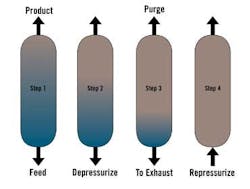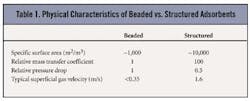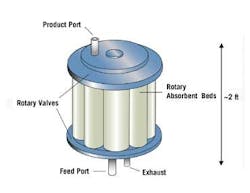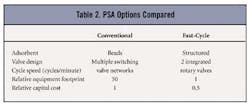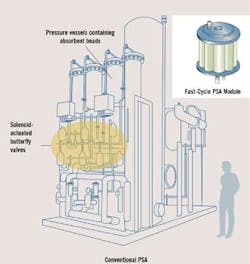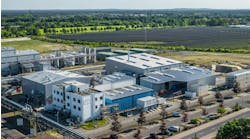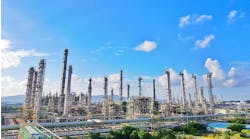Conventional pressure-swing adsorption (PSA) has been used to separate and purify industrial gases for more than 35 years. The technology, first developed by ExxonMobil and Air Liquide in the late 1950s, is based upon the capacity of adsorbents to selectively adsorb and desorb particular gases as gas pressure is raised and lowered. PSA is currently used in applications ranging from the production of nitrogen and oxygen from air to dehydration and hydrocarbon recovery.
New fast-cycle Pressure Swing Adsorption technology is currently being developed, offering more-compact, less-expensive and more-energy-efficient gas separation equipment. This article looks at this new technology and its potential in areas such as hydrogen purification and recovery.
A cyclic process
The PSA process involves a cyclic repetition of four basic steps: production, depressurizing, purging and repressurizing (Fig. 1). First, a gas mixture is fed under high pressure into a vessel containing a bed of 2-6-mm diameter adsorbent beads, typically alumina, silica gel, activated carbon or molecular sieves. Impurities in the feed gas adsorb onto the internal surfaces of the adsorbent, leaving purified product gas in the void spaces of the vessel. Product gas is then withdrawn from the top of the vessel under pressure.
Figure 1. Cyclic Repetition
The four basic steps of pressure-swing adsorption technology selectively adsorb and desorb gases as pressure is raised and lowered.
The pressure in the adsorption vessel is then reduced, and product gas remaining in the void spaces of the vessel is removed. The adsorbed impurities are released back into the gas phase, regenerating the adsorbent bed. The vessel is then purged with a small amount of purified product gas, to complete regeneration of the adsorbent bed. Impurities exit the PSA process in a low-pressure exhaust stream.
Finally, the vessel is repressurized with a mixture of product gas from the depressurization step, feed gas and high-purity product gas. This cycle is repeated every 2-20 minutes in conventional PSA systems.
Since each cycle is essentially a batch process, multiple pressure vessels are used together in sequence to provide a semicontinuous flow of product gas. In addition, large surge tanks are used to dampen variations in flows of feed, product and exhaust streams.
To improve product gas yields, more-complex PSA cycles can be used, involving more intermediate steps such as cocurrent and countercurrent depressurization. A larger number of adsorbent beds are needed for these complex PSA cycles. When determining the optimum process cycle for a given gas purification requirement, an economic tradeoff must be made between increased efficiency and higher capital cost.
In most PSA installations, a complex network of valves is used to switch gases between the adsorbent beds. The valves are actuated by programmable logic controller (PLC)-controlled solenoids. For an eight-bed hydrogen PSA process, 42 valves are typically needed to switch gases, and the number of valves required increases significantly in more complex PSA cycles using larger numbers of adsorbent beds.
Disadvantages of PSA
Despite PSA's widespread use in industry, traditional processes using beaded adsorbents and multiple switching valves have the following inherent disadvantages:
Fluidization: Gas flow through the adsorbent beds, and, by association, the PSA cycle speed, are limited by the fluidization velocity of the adsorbent beads. Fast cycle speeds and rapid gas flows result in fluidization, which leads to abrasion, dusting and, ultimately, destruction of the adsorbent beads. Consequently, slow cycle speeds (2-20 minutes per cycle) and correspondingly large pressure vessels with large adsorbent inventories have to be used, resulting in very large systems, with high materials and vessel costs. The large vessel sizes mean that most conventional PSA systems are field erected, with the associated costs and onsite construction requirements.
Kinetic limitations: The fluidization constraint limits the minimum adsorbent bead size that can practically be used in commercial PSA processes to about 2 mm (1/16 inches) in diameter. This particle size means the adsorbed gas must travel a relatively long diffusion path between the bulk gas stream and the adsorption sites on the internal surfaces of adsorbent macrostructure. This long path results in relatively slow mass transfer between the bulk gas and adsorption sites. High adsorbent inventories and slow cycle speeds are required to compensate for this.
Drawbacks of conventional valves: The networks of individual switching valves, with associated instrumentation, control systems and process piping, add complexity and cost to conventional PSA systems. In addition, the complex piping network required to link the array of valves adds dead volume to the overall PSA process, reducing product yield and overall process efficiency. Solenoid-actuated valves also have high lifecycle costs due to high replacement rates of valve internals.
Enter fast-cycle PSA, a technology that operates at cycle speeds of 100 cycles per minute or greater, significantly faster than conventional PSA.
Now in precommercial development, fast-cycle PSA promises to significantly reduce the size and capital cost of PSA equipment, opening up new applications in a wide range of industries. As an example, prototype fast-cycle PSA systems for purifying 100 Nmch (3,500 scfh) of hydrogen are up to one-fiftieth the size of conventional PSA systems, and cost less than 50 percent as much.
Adsorbents, rotary valves
Two proprietary technologies lie at the heart of fast-cycle PSA: structured adsorbents that replace conventional beaded adsorbents, and integrated rotary valves that replace solenoid-actuated valves.
In fast cycle PSA, the beds of adsorbent beads are replaced with a three-dimensional adsorbent structure featuring a large number of uniform gas channels. The structure's design shortens the diffusion path from the bulk gas phase to the internal surface area of the adsorbent, increasing the mass-transfer rate. The structures also increase the contact surface area of the adsorbent by an order of magnitude, and remove the fluidization limit associated with beaded adsorbents by immobilizing the adsorbent material, allowing for significantly higher bulk gas velocities (Table 1). Both commercially available PSA adsorbents and proprietary, custom-manufactured materials are used in fast-cycle adsorbent structures.
Fast-cycle PSA also simplifies the valving used in traditional PSA, replacing complex valve networks with two low friction, multiport rotary valves (Fig. 2). The rotary valve design has the following advantages:
Figure 2. Simpler Valve Layout with Fast-Cycle PSA
The elements of a rotary fast-cycle hydrogen PSA consist of set of structured adsorbent beds arranged between two rotary valves. The beds rotate around a central shaft. Feed gas enters the PSA module at one end and product gas is withdrawn from the opposite end of the module.
Increased valve switching speed: Rotary valves can be operated reliably at switching speeds of approximately 30 milliseconds, compared to the roughly 10 seconds switching time needed for conventional solenoid actuated valves. Consequently, the rotary valve design can switch gas flows fast enough to allow for PSA cycle speeds of 100 cycles per minute or greater (Table 2).
Complex, efficient PSA cycles: The rotary valve design simultaneously controls multiple gas flows within a single integrated valve assembly, eliminating the piping between valves and beds, and allowing for simple control of complex multistage PSA processes. The complexity, cost and dead-volume issues associated with networks of individual switching valves are avoided.
Improved Durability: Low friction between the rotating valve surfaces means that the rotary valve design is inherently durable compared to more mechanically complex valve designs incorporating impact surfaces and multiple moving parts.
Not perfect
However, like any technology, fast-cycle PSA is not without potential weaknesses. First, while operation at fast cycle speeds results in a significant reduction in the size and cost of the adsorbent beds, the reduction in adsorbent inventory can make fast-cycle PSA systems more vulnerable to process upsets such as contamination by liquid water or other condensable liquids. In such cases, careful design of feed-processing equipment such as liquid knock-out drums placed upstream of the PSA system would prevent any contamination. Alternatively, advanced structured adsorbent designs, using proprietary materials, could be used to prevent contamination.
Another issue is that fast cycle speeds increase the cyclic loading stresses on the adsorbent pressure vessels. This fact must be considered when selecting materials and designing the vessels that house the structured adsorbent.
More-compact units
Fast cycle speed, together with the high mass transfer and high surface area of the structured adsorbent results in a significant increase in the productivity of a unit volume of PSA adsorbent bed. Increased productivity, in turn, results in a direct reduction in the size of adsorbent beds required to produce a fixed flow of purified product gas (Fig. 3).
Figure 3. Super-Size Reduction Cycle PSA
Fast-cycle PSA modules can be up to one-fiftieth the size of traditional PSA modules.
Switching matches cycling
The multiport rotary valves are capable of efficient switching of gases between adsorbent beds to match the fast cycling capability of the structured adsorbent. The rotary valves also allow for the design of highly efficient complex PSA cycles; and fast cycle PSA systems with 6 to 36 individual adsorbent beds have been demonstrated to date. Multibed fast-cycle PSA systems can be efficiently packaged in an integrated, modular rotating bed design. The fast cycle speed and multibed design produces a uniform flow of product and exhaust gas, removing the necessity for large surge tanks on the product and exhaust streams.
The net result of fast-cycle PSA technology: Large field-erected PSA systems made up of multiple vessels of beaded adsorbent, complex process piping and multiple switching valves can be replaced with integrated fast-cycle PSA modules that are one-fiftieth the size of an equivalent PSA production unit (Fig. 3).
In addition, no exotic materials are used in the adsorbent structure or rotary valve designs, which means that materials costs are minimized. Additional benefits include:
Scalability: Fast-cycle PSA technology can be scaled from very small, portable-style devices to large industrial-scale applications.
Modularity: The integrated mechanical design of rotary fast-cycle PSA systems is inherently modular and can easily be skid-mounted. This gives plant operators a high degree of flexibility to reduce equipment installation time and cost, and expand processing capacity to match incremental increases in demand.
QuestAir Technologies is currently developing a small-scale fast-cycle PSA system together with HydrogenSource, a 50:50 joint venture between Shell and United Technologies based in South Windsor, Conn.
This compact hydrogen PSA module, will be integrated into small-scale natural gas reforming systems based on HydrogenSource's proprietary catalytic partial oxidation (CPOx) reformer technology. The integrated hydrogen production and purification product will be marketed for the supply of hydrogen to stationary fuel cell power plants for distributed power generation.
The unit will also be modified for use in skid-mounted systems for on-site production of high-purity (99.999%) hydrogen for industrial uses for volumes in the 20-1,000 Nmch capacity range (700-35,000 scfh). Other potential applications include:
Hydrogen recovery: Several refinery and chemical processes generate large quantities of hydrogen-containing offgas, which is typically flared or burned for low-grade heat recovery. Large-scale fast-cycle PSA presents an economic alternative for the recovery of hydrogen from up to 10 MM scfd of these off-gas streams, for either on-site of over-the-fence use.
Syngas modification: Fast-cycle PSA can be used to tailor the H2/CO ratio of crude syngas for applications including ammonia production.
Methane separations: High natural gas prices have renewed interest in technologies for recovering methane from CO2 contaminated sources such as low-grade natural gas, coal bed methane and various sources of biogas.
Matt Babicki is Principal Engineer of QuestAir Technologies Inc., based in Vancouver British Columbia, Canada. Andrew Hall is a Business Development Manager with QuestAir.

